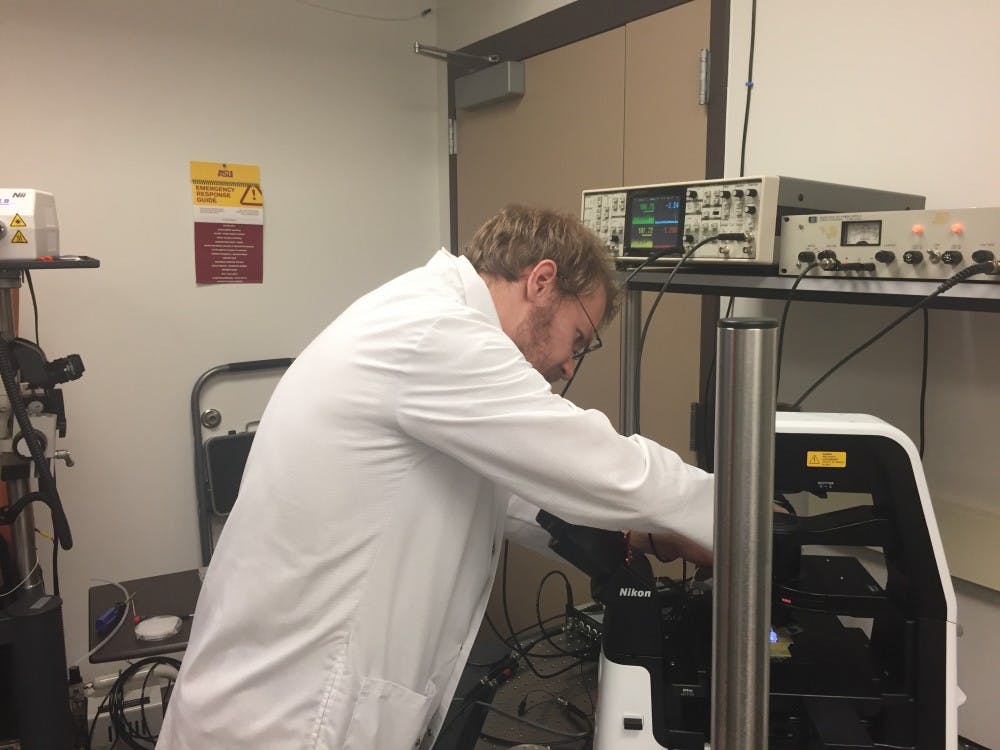When it comes to biophysics, good things come in small packages.
Dr. Quan Qing of ASU’s biophysics department is directing research on nanodevices and their applications, with the possibility of mass-producing them in the future.
“We try to construct devices of a nanoscale or a microscale and see what is the best strategy to put them next to a living cell, or biomolecules,” Qing said.
On this scale, Qing said individual cells dwarf these machines.
Qing said his team creates these machines from the bottom up, using various methods to create each microscopic component.
“Usually we use ten-micron-long wires, so the growth takes about 10 to 15 minutes,” Qing said.
This wire is able to send and receive electrical signals, which the device uses to measure different properties of cells, Qing said.
The size of the device aids in this process. Larger probes that fulfill the same function already exist, but they are more invasive and can impede the measurements, Qing said. They do this by forming scars, he said.
“Once a scar forms, all the cells migrate away from this because the cells won’t like it,” Qing said.
If cells move around, it is difficult to study them long-term. Qing said his smaller machines do not prompt scarring, as they are smaller than individual cells.
Qing said the challenge comes in the delivery of these machines because any sort of injection would leave a hole, resulting in scarring. Qing’s team solved this issue by creating a unique delivery vehicle.
“We can make them small enough and geometrically favorable for the delivery of these devices,” Qing said.
In addition to the development of these microscopic tools, Qing’s group has two other initiatives: collecting biomolecular data and sequencing DNA.
Joshua Sadar, a Ph.D student and researcher in Qing’s lab, studies how to develop nanomachines capable of sequencing DNA.
Sadar said his project could revolutionize medical research because most modern research in medicine relies on statistics, like finding which drug will help the most people.
“Not everyone’s body reacts the same to every treatment,” Sadar said.
The ability to measure a drug’s efficacy through individuals rather than en masse could result in more accurate drug research, Sadar said.
“There is still work to be done in making sequencing technologies that are faster, cheaper, can be mass-produced,” Sadar said.
In order to actually sequence the DNA, these machines send an electrical current through the DNA molecule and different bases resist the current differently, Sadar said. This resistance is recorded, then used to sequence the DNA, he said.
Xiangbing Jiao, a Ph.D student and researcher in Qing’s lab, focuses on utilizing these nanomachines to understand and manipulate cells.
“This is the first time that flexible electronics can be deeply implanted into tissue with accurate positioning,” Jiao said.
Jiao said these cutting-edge devices are able to more accurately collect data on cells. But the nanomachines do more than just receive signals.
“The basic idea here is to build a communication bridge between the animal tissue and the electronic devices,” Jiao said.
He said doing so would allow for a greater understanding of more complex molecular interactions, such as in the brain.
“By this probe, we can build a so-called BMI — a brain machine interface," Jiao said. "So you can either stimulate the brain or get signals from the brain … as long as you get signals from the brain, you can decode those signals.”
Jiao said that by way of this technology, the future may hold some innovations in prosthesis and stem cell research. Through analyzing the electrical signals in the brain, it may be possible to create prosthesis that are controllable through thought, he said.
Likewise, by stimulating stem cells, researchers may be able to accurately influence their development, allowing for the regeneration of limbs, Jiao said.
“We are trying to play the role of the person who can give orders directly to the cells, which no one has ever done before,” Jiao said.
Reach the reporter at chawk3@asu.edu
Like The State Press on Facebook and follow @statepress on Twitter.




